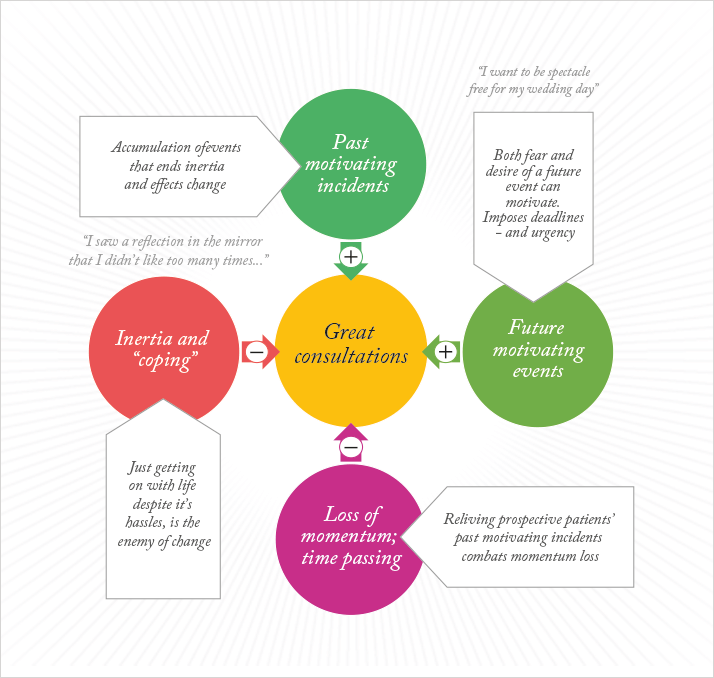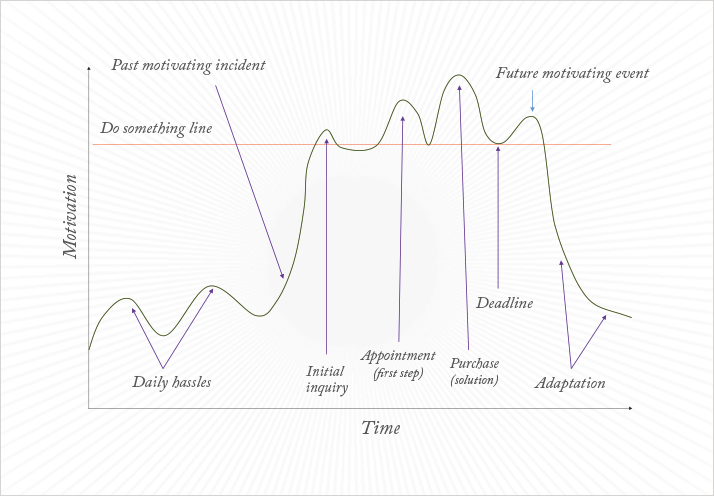



- To have a great consultation, you need to address the psychological barriers your prospective patient has against the procedure
- Getting people to understand their historical motivations for making that change turns inertia and action
Future events (like a wedding or vacation) impose a deadline that also represents a strong motivation for change - Understanding these factors during a consultation can help motivate prospective patients to fulfil their desire, and undergo the procedure
In the 15+ years that I’ve spent working with ophthalmologists, I’ve often not envied some of the challenges that you face. One big one being marketing, because it relies on the patient understanding your explanation of the differences between one medical offering and another, and because the concept of promoting a medical solution doesn’t come easily to you.
Nobody trained you in sales
If you’re an ophthalmologist offering laser refractive surgery, for example, you may often feel as though you have to “sell” to the person who walks into your consultation room, not simply because you’re offering an elective procedure, but also because you work in a commercial business. When you consider that it takes that person an incredible amount of time to even pluck up the courage to make a telephone enquiry, let alone actually undergo the procedure, the task of educating and promoting becomes a challenging one. Effective consultations aren’t about convincing or persuading patients to do things that they don’t want to do. They’re about removing obstacles that stop people from doing the things they really want to do.When enough is enough
A remarkable quality of humankind is the ability to adapt. When faced with challenges, we adapt, mitigate and modify our behaviors. We cope. It’s a wonderful aspect of our personalities – and it enables us to get on with our lives, despite the constant stream of everyday hassles and setbacks. This characteristic can also be limiting. Instead of taking the bull by the horns and dealing with issues, we can just let them slide, ignoring them for far too long. When eventually, the hassles get too much to bear, we experience what I describe as a Past Motivating Incident (PMI, Figure 1). This PMI might be just another daily hassle, but somehow, through repetition or intensity, it marks the time when you’ve had enough. It’s the “straw that breaks the camel’s back” and exceeds our power to adapt – and it enables you to cross the threshold that separates inertia and action. So it’s usually shortly after experiencing the PMI that patients make an initial inquiry with an ophthalmologist.
That momentum might start to ebb away after the initial call or consultation though, back towards the lethargy of “making do” (Figure 2). You can do something about that to help. Getting prospective patients to relive their PMIs during the initial enquiry is an extremely effective way of helping them take that next step – to make an appointment for a consultation – and it reinforces their decision once they’ve made it. I advise people to ask open questions that enable patients to remember and share these incidents with them. Retelling painful memories enable prospective patients to re-identify with whatever it was that lead them towards action in the first place.

I also instruct ophthalmologists to use these approaches at consultations. There will be a gap between the first call and the appointment – meaning that the prospective patient is even further away from their PMI. People might have a dip in motivation at this time, which may lead to cancellation requests. Should the commitment to an appointment lead them to attend, they still might need help in reconnecting with their emotional needs to motivate further action: a commitment to have the procedure.
The moment they say “yes” is also an excellent time to prompt prospective patients to remember the reasons why they want to undergo the procedure. I find that doing so reinforces their decision, it could also reduce any regrets and may, ultimately, lead to better testimonials and recommendations. The PMI is an important concept that is easy to understand and relate to, but almost never used in selling situations. It is by far, one of the most useful concepts in my inventory of tools.
Pleasure and pain
The PMI’s partner is what I call the Future Motivating Event (or the FME, Figure 1): a deadline – a reason for urgency that often helps prospective patients commit to their choice. The reason is often a pleasurable one, hence a good motivator. We are all driven by deadlines to a certain degree, but sometimes what a patient wants isn’t clearly timely. Despite this, FMEs can be used to reinforce people’s motivations for change. I instruct ophthalmologists to ask their prospective patients how they see the future after the solution has been gained. What might be coming up that they might be able to enjoy more, having the solution in place? What painful future will they avoid, if they take action now? Asking these questions makes the person sitting in your office visualize their happier future, and gets them to associate their FME with solving their problems. That solution can now be accompanied by a deadline, and all of a sudden, a problem that has an associated deadline gathers a sense of urgency. Often, this is exactly what’s needed – the prospective patient’s own urgency – to help them motivate themselves to take action, like booking surgery.Leveraging human motivation
This strategy is far more compelling to a patient than any incentive or time-limited offer you could provide. It’s more compelling, because it’s all about them and what they want, and not about what and when you want to sell something to them. Having a strong FME is a great asset you collect at the consultation, and can often be one of the most effective tools you have when dealing with objections. Having a strong FME will also reduce the need for you to feel like you’re applying any pressure to the consultation. In the end, once you help them associate a future event with the solution they are seeking, they’ll need no further convincing from you to take that leap.Rod Solar is the Director of Client Services with LiveseySolar, and is responsible for delivering sales, customer service and communications training to LiveseySolar’s clients.
